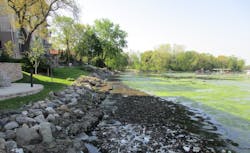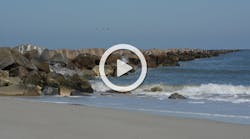About the author: Eric Seidl is sales manager for Envirolock. Seidl can be reached at [email protected].
Outside of urban residential neighborhoods, waterfront homes were once remote and rustic, focusing on small living quarters, native vegetated shorelines, and small access points for fishing and small water craft. With the affordable housing boom of the 1950s and the introduction of the motorized watercraft, waterfront residential living experienced a change in its use and intensity.
By the 1960s, many states recognized the changing quality of water in urban and rural waterways. More roofs, driveways and large lawns meant less native vegetation and a lower ability to filter and infiltrate runoff. Larger boats and expansive swimming beaches altered the shorelines' ability to deal with slope, fetch and moving water. Natural shorelines were being replaced with stone or man-made materials. Crystal clear lakes were flooded with pollutants and sediment from runoff. Residents that once had access to clean waterways for swimming and fishing began to see a change in their ability to enjoy waterfront living. The resulting downfall of limited access to recreational tourism became the driving force to the birth of the first shoreline zoning ordinances. Since the late 1960s, shoreline zoning codes have worked to increase water quality by limiting direct runoff, improving natural landscape buffers along the shoreline and, most recently, requiring mitigation of storm water runoff.
Collaboration is Key
Residential shoreline zoning may appear complex and costly from the outside; there may be multiple agencies, such as state, county, municipal and federal regulatory agencies. In addition, there is the property owner, contractor, designer, and sometimes the product manufacturer or representative. The intensity of these ordinances changes between states, counties and municipalities, making it complex for designers and contractors. Although the end goal is clean and healthy shorelines, each person may have a different approach or agenda. By planning and following a few steps, you can simplify the shoreline zoning code interpretation and implementation.
Collaboration is the key to simple and successful implementation of shoreline zoning codes. This takes the right team and a focus on communication. If the designer is brought into shoreline improvements after the process has started, the homeowner may be frustrated by the time and money invested in the process when it is their land. The contractor might blame everything from cost to materials to timing on the regulatory agency, and many regulatory agencies are limited in the amount of time available in the field and follow up. Often, everyone is overwhelmed before the project is even designed. If approached in this manner, it can be defeating for everyone. A property owner is not likely to maintain vegetative buffers and storm water facilities if they feel they are being forced. The result often is the “ask for forgiveness” approach.
No matter what role you play, be a leader. Understand your team and audience. The goal is to create a simple approach that will make the process easier. Listen to the client and, most importantly, listen to the land. Learn what the space is capable of by understanding the topography, the soils, the vegetation, the space's relationship to the water and how it is affected by use. Collaboration means understanding each role and how each player defines their desired outcome.
Runoff carries trash, debris and sediment as it erodes the shoreline.
All About Attitude
Knowing the audience means speaking its language. While sustainable solutions may be top priority, the property owner may be more interested in family gatherings, views of and access to the water, and cost. Do not focus on why the solution is green; instead, focus on why the proposed solution will save the homeowner time and money. Focus on the reason they have the property and the investment. For example, if they love to fish, focus on how a natural shoreline will bring more desirable fish species and how the design and selected materials will save them money. They do not need to know they are helping the planet, unless that is their driver.
In addition, keep the process as positive as possible. In a collaborative approach, education and empowerment play a huge role. If a contractor understands how regulatory codes will help the business, they will be more apt to embrace the ordinance. When it comes to reviewing multiple approaches, a cost-benefit analysis is a quick and simple way to support the right approach. Upfront cost always is on everyone’s mind, so do not stop at analyzing the initial project investment. It is great for a property owner or municipality to know that the proposed project will initially cost $50,000, but what will it cost three, five or 10 years down the road? When will it need to be replaced? How much time or money will it take to maintain on an annual basis? For a public project, will they need to consider additional tools or support staff to maintain the proposed project? No system is maintenance-free. If the client is not ready to maintain porous pavers or an extensive landscape buffer, search for alternative solutions.
When it comes to shoreline and streambank stabilization, the erosion control industry is inundated with a variety of products. It is vital that industry professionals understand the capabilities of products on the market. Engineers, regulatory agencies and contractors appreciate when solution providers do not force their product on the client. It may mean the loss of an initial sale, but it results in future business and relationships. By taking an active collaborative approach, a manufacturer should work with the team to better understand what tools they need to continue to develop and refine, and how it can develop new products to make the next project more successful. This type collaboration allows for improved components, installation and vegetation.
Ongoing Maintenance
To be successful, project follow up is necessary. This does not mean the project team needs to make routine stops and have lengthy site visits to succeed. With technology, there are simple and cost-effective tools that will make life easier. Start by developing a maintenance schedule or checklist for the client, and give them tips on what to look for and why. An annual inspection checklist and schedule could save hours of future site meetings and customer service. Once you develop this tool, you can reuse it.
The appeal of water and waterfront living will continue to grow. With that growth, the industry will need to continue to update and improve regulations along waterways and throughout watersheds. Current and future shoreline zoning ordinances will need to evolve with development and climate change. The collaborative approach allows opportunity to continue to shape the future landscape of our waterways.




